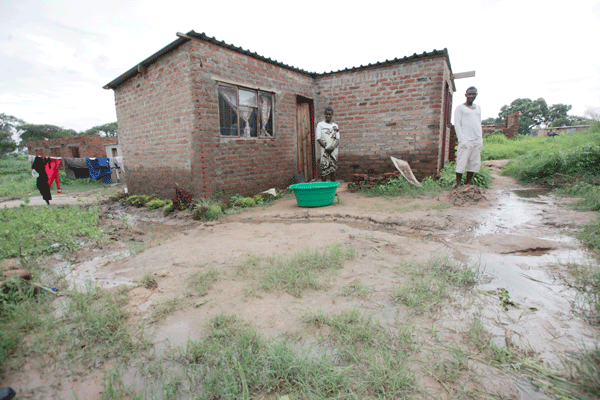
Looking at the sky, his face seemingly disturbed by the dark clouds above, Marlon Sixpence (not his real name) mutters something like “yakuuya futi” [the rains are coming again]’.
news in depth BY TAPIWA ZIVIRA

He is referring to the rains, which have incessantly pounded the country in the past weeks causing floods in many parts of the country.
Sixpence’s fear is that each time it rains, the house he calls home — which is built on undesignated land on the edges of Mukuvisi River near Glen View 7 suburb of Harare — gets flooded.
“It is a nightmare,” he says wiping a raindrop off his forehead as he leads us into his house.
Inside is a double bed that is supported by bricks on all corners, apparently to keep it safe from getting soaked, and in one corner there is a laundry line on which wet clothes hang loosely.
The few possessions in the house — a single door kitchen cabinet, a push tray, and a chest of drawers that serves as a wardrobe — are all laid on a bed of bricks, but it appears too late as they all have traces of moisture on their bases.
The other room, which normally serves as the kitchen and bedroom for his six-year-old child, looks deserted and water covering an estimated height of 30 centimetres has collected inside it.
- Chamisa under fire over US$120K donation
- Mavhunga puts DeMbare into Chibuku quarterfinals
- Pension funds bet on Cabora Bassa oilfields
- Councils defy govt fire tender directive
Keep Reading
“Because of the situation, we have abandoned the other room as it is directly in the line of a ditch that leads to Mukuvisi, so whenever it rains, water gushes in,” he said.
Sixpence and hundreds others here are among the many Harare residents who have built their houses on illegal settlements in Harare.
As a result of Zanu PF dangling land as a carrot to woo urban voters, dozens of informal settlements have sprouted in the city, with many of them located on wetlands and river banks.
The bulk of the settlements lack the requisite water and sanitation facilities and more importantly, they do not have functioning drainage systems, neither are they built in a systematic way —they are scattered all over, making any attempts to regularise them impossible.
Without proper road infrastructure, water sources and sewer systems, the residents of the new settlements often end up digging up wells and constructing pit latrines wherever they like, putting themselves at risk of contracting diseases.
Here in Sixpence’s neighbourhood, it is not just the flooding that is a problem.
Because the houses are on a wet, sloped terrain, effluent from some pit latrines freely flows out, putting the residents at the risk of contracting diseases such as the deadly typhoid.
Near one of the latrines, a three-year old plays with the muddy water, oblivious of the danger it poses to his health.
According to Sixpence, the “stands”, which were dished out by some Zanu PF officials, were meant to be “temporary”.
“I know they are not regular, but economic hardships forced me to move from my former lodgings in Glen View 8 to come here and build this house. I know I can be forced out any time, so I will not invest further into the house,” he said.
“Rather, I will endure the floods. I know they will end soon,” Sixpence added, taking a shovel to scoop water out of his house.
Harare City Council, which has the obligation to construct and inspect drainage and sanitation systems in residential stands, has washed its hands on the irregular stands dished out by Zanu PF.
In a recent interview with this paper, Harare mayor Bernard Manyenyeni said in many cases, the city was not consulted as should happen during the development of new residential stands.
“Every piece of land should fall under some town planning authority, but to the best of my knowledge, there is no town planning involved at some of these ‘rally’ stands,” he said. “We hear it [allocation of housing stands] on the news.”
In Budiriro, about 30 families were this week evacuated after their homes, which were built close to a river, got flooded.
The city’s spokesperson Michael Chideme has since promised that Harare would carry out investigations on cases of flooding to “ascertain the authenticity of the layout plan and whether the affected stands were within the approved plan.” Sixpence’s area, which is not regular, will, with no doubt, be subject of the investigations.
However, the rains have not only caused havoc in undesignated areas. in Highfield, some residents are currently experiencing floods caused by blocked drainage systems.
In New Canaan, The Standard witnessed dozens of houses flooded with water that was spilling from the blocked drains.
Shepherd Nyandoro told The Standard that despite constructing a metre high barrier to stop the water from spilling into his home, he now feared for the worst as flooding continues.
“The water is all over the yard every time there is heavy rain and this affects walls, which may collapse over time,” he said.
According to the Environmental Management Agency, construction of houses in areas such as Budiriro 5, Monavale, Malborough and Chitungwiza had made Harare more vulnerable to flash floods.
The agency said the construction of malls, churches and residential houses “had compromised the ability of wetlands to reduce flooding because the wetlands are being turned into concrete jungles.”
“Naturally, wetlands control and reduce flooding because of the spongy-like characteristics that they have which allow them to absorb excess water,” EMA said.
“Due to the normal to above normal rainfall currently being experienced in the country, people who have built on wetlands in areas such as Budiriro 5, Monavale, Chitungwiza, Marlborough, among others, are battling with flash floods on a daily basis.”
The government has over the years controversially approved major construction projects on wetlands such as the Chinese owned Longcheng Plaza Mall near the National Sports Stadium.
Warnings by conservationists that the construction of the mall would damage the ecologically-sensitive area in Belvedere and harm the city’s water sources were brazenly ignored.
Meanwhile, Harare and Chitungwiza councils have been blamed for the flash floods by residents associations who say poor drainage has contributed to the disaster.
“While we appreciate the clearing of storm water drains that is currently underway in Chitungwiza, we feel that the Chitungwiza Municipality should have done this late last year in preparation for the rainy season,” the Chitungwiza Residents Trust said.
“It is better to be well-prepared in time than to be reactionary. Some residents are experiencing floods in their areas, mostly those from low-lying and swampy areas of the town.”
The rains have also worsened the state of the two cities’ poorly maintained roads with potholes now a common phenomenon.
Countrywide, the Civil Protection Unit has reported that 20 homes and a school were severely damaged by hailstorms which pounded Umguza District, leaving some villagers homeless.
A reader from Kadoma, said her home and many others have been flooded and property has been damaged as a result while in Norton, there were reports that some houses built on wetlands had also experienced floods.










